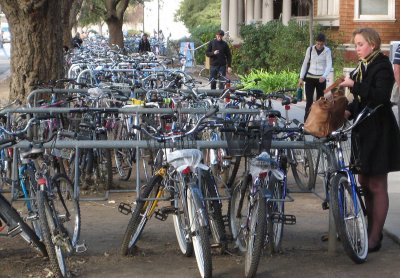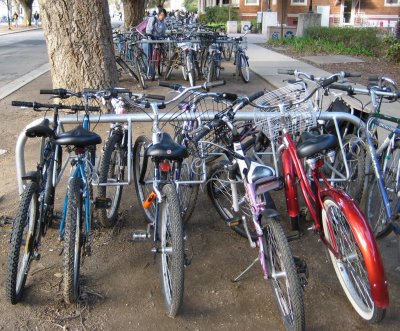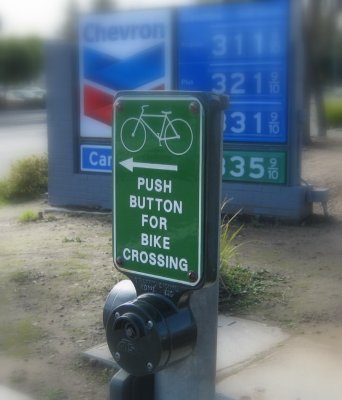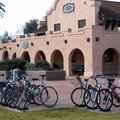 It's all about the bicycle in Davis. I visited the college town last week to get a glimpse of what life would be like in the US if everyone decided to stop feeding ExxonMobil's profits and turned to bicycling instead.
It's all about the bicycle in Davis. I visited the college town last week to get a glimpse of what life would be like in the US if everyone decided to stop feeding ExxonMobil's profits and turned to bicycling instead.
It was perfect, two-wheeled bliss. Miles of bicycle lanes criss-cross the town and acres of bike parking are spread across the UC-Davis campus.
This is the bicycle-friendliest community in the US. That's not me saying it. The League of American Bicyclists bestowed the “platinum level” to Davis in the Bicycle Friendly program in 2005.
Just visiting
 With just a couple of hours to visit Davis before my flight left Sacramento last week, I rented a bike at Ken's Bike and Ski. All they had in my size was a “girl's” Raleigh. I didn't care. I just wanted to experience Davis by bicycle. I was offered a free helmet and bicycle lock and picked up a free bike map of Davis.
With just a couple of hours to visit Davis before my flight left Sacramento last week, I rented a bike at Ken's Bike and Ski. All they had in my size was a “girl's” Raleigh. I didn't care. I just wanted to experience Davis by bicycle. I was offered a free helmet and bicycle lock and picked up a free bike map of Davis.
I saw people riding bikes on every street in town and all around campus, which prohibits motor vehicles in many locations. Bike racks are installed in front of businesses all over town and throughout the campus. There are special crossing signals for bikes at some intersections; at others bike paths go over or under the road.
This must be what it's like in Amsterdam or Copenhagen.
Motivation
There's a good reason why the city and campus adopted this bike culture. The graduate and undergraduate population is 30,000 students, not counting faculty and staff. The city's population has grown from 6,000 to 60,000 in the last 40 or 50 years.
Adding that many more cars to the road network would create daylong gridlock. Imagine the impact of providing parking, roads and traffic control for all the cars.
Davis must have anticipated that, as it started considering bicycle use in its transportation infrastructure back in the 1960s. Some forward-thinking cities are just now putting those words to paper in the complete streets program.
— 95% of arterials and connectors have bike lanes
— 27 locations where bike paths go over, or under, the road
— $14 million spent on bicycle projects in 10 years
— $100,000 budgeted for bike lane maintenance
— 17% of trips are made by bicycle
Observations
Considering that I only spent about two hours tooling around the town on a bike, here are some of my observations.
Motorists are more considerate: Bikes share the streets with cars and motorists are very aware of them. It's easy to make eye contact with drivers at intersections, and bike lanes are engineered to prevent collisions.
People ride every kind of bike: I saw very few expensive racing bikes. I did see lots of cruisers, mountain bikes, hybrid bikes, a Chinese Phoenix bike, and hundreds of your basic beaters.
More observations
No spandex: Since I was there midday on a Wednesday, I didn't see anyone in basic bicycle kit. Everyone was dressed “come as you are.”
 No lube: Maybe because it had been raining a lot lately and the bikes have been sitting out, I heard lots of squeaky chains.
No lube: Maybe because it had been raining a lot lately and the bikes have been sitting out, I heard lots of squeaky chains.
No hurry: None of the bicyclists seemed in a particular hurry on the streets. Most people stuck to the bike lanes, would stop at the lights, slow to a roll at stop signs.
Ride at your own risk: Riding through campus at class change is an exhilarating experience. It's like riding in a peloton, except bikes and pedestrians are coming at you from all directions. I steered through it in white-knuckled fright, but everyone else seemed unconcerned. Roundabouts at intersections keep everything safe.
Traffic counts on several bike paths around town show five with more than 1,000 bikes a day; one gets over 6,000. The busiest location is the Russell Boulevard bike path east of Sycamore Lane which got 614 bikes in one p.m. peak hour.
At least one busy intersection has a special traffic signal for bicycles only.
UC-Davis students are required to buy a $8 license, good for three years.
The city and college both provide bike lockers for rent.
UC Davis students, faculty and staff can get free showers, locker and towels on arrival to work or classes.
The UC Davis BikeBarn offers repair and maintenance courses, repair stands and tool-loan service for do-it-yourselfers.
Back home
 That visit to Davis helped me see how a city can improve by embracing a bike culture. Bicycle transportation planning shouldn't be something that's just dished out to satisfy a few vocal bicycle advocates in town. It should be part of every decision made regarding streets and highways.
That visit to Davis helped me see how a city can improve by embracing a bike culture. Bicycle transportation planning shouldn't be something that's just dished out to satisfy a few vocal bicycle advocates in town. It should be part of every decision made regarding streets and highways.
Fortunately for Davis, it started using the bicycle as a solution for traffic congestion 40-some years ago. Other cities should adopt those priorities immediately, so one day they can reap the same benefits from bicycle use that Davis receives.




Recent Comments